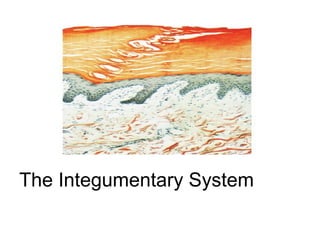
Part 1 the integumentary system(ai-ann)
- 2. The Integumentary System Integument is skin Skin and its appendages make up the integumentary system A fatty layer (hypodermis) lies deep to it Two distinct regions Epidermis Dermis
- 3. Functions of skin Protection Cushions and insulates and is waterproof Protects from chemicals, heat, cold, bacteria Screens UV Synthesizes vitamin D with UV Regulates body heat Prevents unnecessary water loss Sensory reception (nerve endings)
- 4. Epidermis Keratinized stratified squamous epithelium Four types of cells Keratinocytes – deepest, produce keratin (tough fibrous protein) Melanocytes - make dark skin pigment melanin Merkel cells – associated with sensory nerve endings Langerhans cells – macrophage-like dendritic cells Layers (from deep to superficial) Stratum basale or germinativum – single row of cells attached to dermis; youngest cells Stratum spinosum – spinyness is artifactual; tonofilaments (bundles of protein) resist tension Stratum granulosum – layers of flattened keratinocytes producing keratin (hair and nails made of it also) Stratum lucidum (only on palms and soles) Stratum corneum – horny layer (cells dead, many layers thick) (see figure on next slide)
- 5. Epithelium: layers (on left) and cell types (on right)
- 6. Remember… Four basic types of tissue Epithelium – epidermis just discussed Connective tissue - dermis Muscle tissue Nervous tissue
- 7. Dermis Strong, flexible connective tissue: your “hide” Cells: fibroblasts, macrophages, mast cells, WBCs Fiber types: collagen, elastic, reticular Rich supply of nerves and vessels Critical role in temperature regulation (the vessels) Two layers (see next slides) Papillary – areolar connective tissue; includes dermal papillae Reticular – “reticulum” (network) of collagen and reticular fibers
- 8. *Dermis layers *Dermal papillae * *
- 9. Epidermis and dermis of (a) thick skin and (b) thin skin (which one makes the difference?)
- 10. Fingerprints, palmprints, footprints Dermal papillae lie atop dermal ridges Elevate the overlying epidermis into epidermal ridges Are “sweat films” because of sweat pores Genetically determined Flexion creases The dermis is the receptive site for the pigment of tattoos Deep dermis, from continual folding Fibers Collagen: strength and resilience Elastic fibers: stretch-recoil Striae: stretch marks Tension lines (or lines of cleavage) The direction the bundles of fibers are directed
- 11. Hypodermis “Hypodermis” (Gk) = below the skin “Subcutaneous” (Latin) = below the skin Also called “superficial fascia” “fascia” (Latin) =band; in anatomy: sheet of connective tissue Fatty tissue which stores fat and anchors skin (areolar tissue and adipose cells) Different patterns of accumulation (male/female)
- 12. Skin color Three skin pigments Melanin:the most important Carotene: from carrots and yellow vegies Hemoglobin: the pink of light skin Melanin in granules passes from melanocytes (same number in all races) to keratinocytes in stratum basale Digested by lysosomes Variations in color Protection from UV light vs vitamin D?
- 13. Skin appendages Derived from epidermis but extend into dermis Include Hair and hair follicles Sebaceous (oil) glands Sweat (sudoiferous) glands Nails
- 15. Nails Of hard keratin Corresponds to hooves and claws Grows from nail matrix
- 16. Hair and hair follicles: complex Derived from epidermis and dermis Everywhere but palms, soles, nipples, parts of genitalia *“arrector pili” is smooth muscle * Hair bulb: epithelial cells surrounding papilla Hair papilla is connective tissue________________
- 17. Functions of hair Warmth – less in man than other mammals Sense light touch of the skin Protection - scalp Parts Root imbedded in skin Shaft projecting above skin surface Make up of hair – hard keratin Three concentric layers Medulla (core) Cortex (surrounds medulla) Cuticle (single layers, overlapping)
- 18. Types of hair Vellus:fine, short hairs Intermediate hairs Terminal: longer, courser hair Hair growth: averages 2 mm/week Active: growing Resting phase then shed Hair loss Thinning – age related Male pattern baldness Hair color Amount of melanin for black or brown; distinct form of melanin for red White: decreased melanin and air bubbles in the medulla Genetically determined though influenced by hormones and environment
- 19. Sebaceous (oil) glands Entire body except palms and soles Produce sebum by holocrine secretion Oils and lubricates
- 20. Sweat glands Entire skin surface except nipples and part of external genitalia Prevent overheating 500 cc to 12 l/day! (is mostly water) Humans most efficient (only mammals have) Produced in response to stress as well as heat
- 21. Types of sweat glands Eccrine or merocrine Most numerous True sweat: 99% water, some salts, traces of waste Open through pores Apocrine Axillary, anal and genital areas only Ducts open into hair follices The organic molecules in it decompose with time - odor Modified apocrine glands Ceruminous– secrete earwax Mammary – secrete milk
- 22. Disorders of the integumentary system Burns Threat to life Catastrophic loss of body fluids Dehydration and fatal circulatory shock Infection Types First degree – epidermis: redness (e.g. sunburn) Second degree – epidermis and upper dermis: blister Third degree - full thickness Infections Skin cancer
- 23. Burns First-degree (epidermis only; redness) Second-degree (epidermis and dermis, with blistering) Third-degree (full thickness, destroying epidermis, dermis, often part of hypodermis)
- 24. Estimate by “rule of 9’s” Critical burns Over 10% of the body has third- degree burns 25 % of the body has second- degree burns Third-degree burns on face, hands, or feet
- 25. Tumors of the skin Benign, e.g. warts Cancer – associated with UV exposure (also skin aging) Aktinickeratosis - premalignant Basal cell - cells of stratum basale Squamous cell - keratinocytes Melanoma – melanocytes: most dangerous; recognition: A - Asymmetry B - Border irregularity C - Colors D - Diameter larger than 6 mm
- 26. Skin Cancer Sqaumous cell carcinoma Basal cell carcinoma Melanoma
